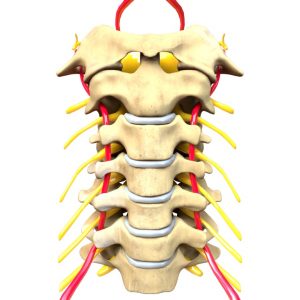Cervical Vertebrae Definition
The cervical vertebrae are the bones within the neck. The vertebrae are the bones that make up the backbone of vertebrate animals. These cervical bones are the smallest in the body in mammals, although they are not the smallest bones found within the animal. The bones are identified as C1 through C7, and they increase in size as you move down the body.
The C1 vertebra is also known as the atlas. It sits at the base of the skull and forms the atlanto-occipital joint. The next vertebra, C2, is known as the axis, and it forms the atlanto-axial joint. These are important for the movement of the head and neck, including the action of nodding.
In some species of animals, there are ribs located on the cervical vertebrae, similar to the ribs that are located on the thoracic vertebrae. These ribs can be large in some animals, such as lizard species, while they tend to be small in birds.
The cervical vertebrae are illustrated in the below image, which shows a computer-generated model of C1 through C7:
Cervical Vertebrae Function
The cervical vertebrae are responsible for movements of the head and neck. They are relatively mobile and allow flexion and extension of the joints between the vertebrae, which helps to produce movement. The atlanto-occipital joint has also been dubbed the “yes” joint because the joint allows you to nod your head. The atlanto-axial joint is the “no” joint, allowing you to shake your head. The rest of the cervical vertebrae contribute to this movement through rotation, flexion, and extension.
Cervical Vertebrae Structure
The cervical vertebrae have varying structures depending on their location in the neck. C1, or the atlas, is the only vertebra without a body; instead, it articulates with C2, the axis, at the odontoid process, a bony knob. C2 has a large perpendicular process known as the dens, and its body extends down, covering part of C3.
The vertebrae C3 through C6 have a more regular shape. They have small bodies, with pedicles that extend backwards and laterally. These vertebrae have large vertebral foramen in the transverse processes, which the vertebral artery, veins, and inferior cervical ganglion pass through. The spinous process of each vertebrae is short, which means that some muscles attach to the nuchal ligament rather than the spinous process itself. This process is a normal attachment point for muscles throughout the remaining vertebrae. The articular processes are fused to form articular pillars. The cranial spinal nerves pass above the corresponding cervical vertebrae, meaning cranial nerve 5 passes above C5.
C7 is also known as the vertebra prominens. It has a longer spinous process than most of the other vertebrae, which is largely horizontal in its orientation. In some mammals, there is an extra rib associated with this vertebra. It also contains a sulcus for cranial nerve 8 to run along. The transverse processes are large, but in most animals, the transverse foramen tends to be smaller than in the other cervical vertebrae.
Why is it Important
Injuries to the cervical vertebrae are uncommon but possible, often resulting in significant disabilities. Paralysis can occur, as can death. The most common areas of injury in the cervical spine are C2, C4, and C5, with odontoid fractures being one of the more common injury patterns seen.
When people are injured and transported, they often have their neck immobilized with a brace, preventing further injury from occurring at the cervical spine. This practice is being studied, however, since unstable injuries are not common.
Another source of cervical vertebrae problems is degenerative changes. These can include stenosis of the intervertebral discs, as well as osteophyte formation. These are bony projections that form along joints and can limit the joint’s range of motion, as well as causing pain or discomfort. These conditions have to be diagnosed on a radiograph, also known as an X-ray, with a grading scale ranging from no bony changes to severe disc narrowing or osteophyte formation.
Injuries can also occur due to whiplash, largely relating to how mobile the cervical vertebrae are. There is not as much muscle in the cervical region to protect and support the neck. These bones are also smaller than the other vertebrae but are responsible for supporting the heavy weight of the head, so sudden movements can produce damage to the underlying tissues.
Quiz

